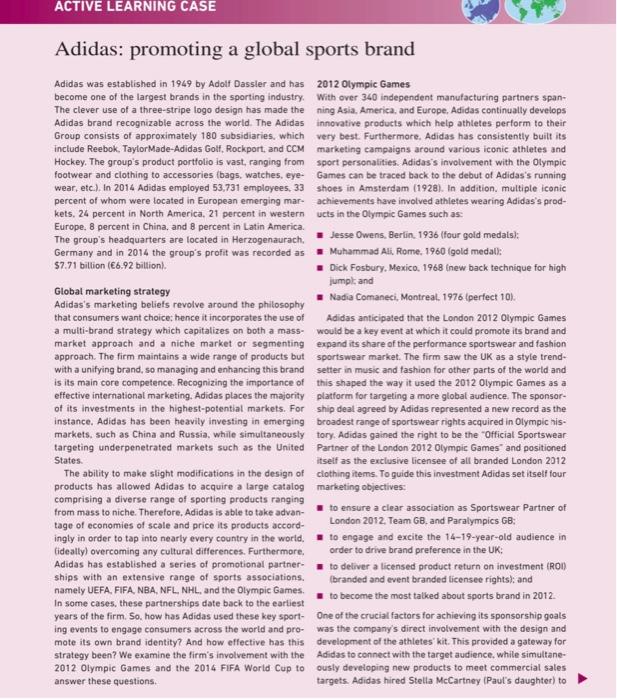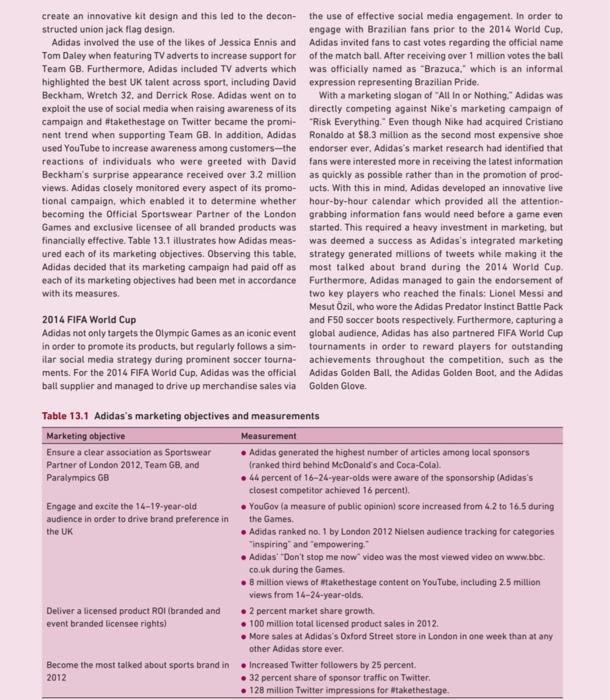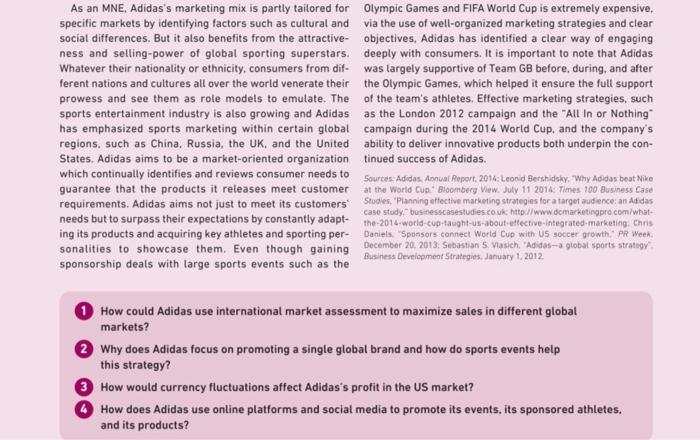Answered step by step
Verified Expert Solution
Question
1 Approved Answer
i need answers to the 4 questions pleaseeeee ACTIVE LEARNING CASE Adidas: promoting a global sports brand 2012 Olympic Games Adidas was established in 1949
i need answers to the 4 questions pleaseeeee 


ACTIVE LEARNING CASE Adidas: promoting a global sports brand 2012 Olympic Games Adidas was established in 1949 by Adolf Dassler and has become one of the largest brands in the sporting industry. The clever use of a three-stripe logo design has made the Adidas brand recognizable across the world. The Adidas Group consists of approximately 180 subsidiaries, which include Reebok, TaylorMade-Adidas Golf, Rockport, and CCM Hockey. The group's product portfolio is vast, ranging from footwear and clothing to accessories (bags, watches, eye- wear, etc.). In 2014 Adidas employed 53,731 employees, 33 percent of whom were located in European emerging mar- kets, 24 percent in North America. 21 percent in western Europe. 8 percent in China, and 8 percent in Latin America. With over 340 independent manufacturing partners span- ning Asia, America, and Europe, Adidas continually develops innovative products which help athletes perform to their very best. Furthermore, Adidas has consistently built its marketing campaigns around various iconic athletes and sport personalities. Adidas's involvement with the Olympic Games can be traced back to the debut of Adidas's running shoes in Amsterdam (1928). In addition, multiple iconic achievements have involved athletes wearing Adidas's prod- ucts in the Olympic Games such as: The group's headquarters are located in Herzogenaurach. Germany and in 2014 the group's profit was recorded as $7.71 billion (6.92 billion). Jesse Owens, Berlin, 1936 (four gold medals): Muhammad Ali, Rome, 1960 (gold medal): Dick Fosbury, Mexico, 1968 (new back technique for high jump) and Global marketing strategy Nadia Comaneci, Montreal, 1976 (perfect 10). Adidas's marketing beliefs revolve around the philosophy that consumers want choice; hence it incorporates the use of a multi-brand strategy which capitalizes on both a mass market approach and a niche market or segmenting approach. The firm maintains a wide range of products but with a unifying brand, so managing and enhancing this brand is its main core competence. Recognizing the importance of effective international marketing. Adidas places the majority of its investments in the highest-potential markets. For instance, Adidas has been heavily investing in emerging markets, such as China and Russia, while simultaneously targeting underpenetrated markets such as the United States. Adidas anticipated that the London 2012 Olympic Games would be a key event at which it could promote its brand and expand its share of the performance sportswear and fashion sportswear market. The firm saw the UK as a style trend- setter in music and fashion for other parts of the world and this shaped the way it used the 2012 Olympic Games as a platform for targeting a more global audience. The sponsor- ship deal agreed by Adidas represented a new record as the broadest range of sportswear rights acquired in Olympic his- tory. Adidas gained the right to be the "Official Sportswear Partner of the London 2012 Olympic Games and positioned itself as the exclusive licensee of all branded London 2012 clothing items. To guide this investment Adidas set itself four marketing objectives: to ensure a clear association as Sportswear Partner of London 2012. Team GB, and Paralympics GB: to engage and excite the 14-19-year-old audience in order to drive brand preference in the UK; The ability to make slight modifications in the design of products has allowed Adidas to acquire a large catalog comprising a diverse range of sporting products ranging from mass to niche. Therefore, Adidas is able to take advan- tage of economies of scale and price its products accord- ingly in order to tap into nearly every country in the world, (ideally) overcoming any cultural differences. Furthermore, Adidas has established a series of promotional partner ships with an extensive range of sports associations. namely UEFA, FIFA, NBA, NFL, NHL, and the Olympic Games. In some cases, these partnerships date back to the earliest years of the firm. So, how has Adidas used these key sport- ing events to engage consumers across the world and pro- mote its own brand identity? And how effective has this strategy been? We examine the firm's involvement with the 2012 Olympic Games and the 2014 FIFA World Cup to answer these questions. to deliver a licensed product return on investment (ROI) (branded and event branded licensee rights); and to become the most talked about sports brand in 2012. One of the crucial factors for achieving its sponsorship goals was the company's direct involvement with the design and development of the athletes kit. This provided a gateway for Adidas to connect with the target audience, while simultane- ously developing new products to meet commercial sales targets. Adidas hired Stella McCartney (Paul's daughter) to create an innovative kit design and this led to the decon- structed union jack flag design. Adidas involved the use of the likes of Jessica Ennis and Tom Daley when featuring TV adverts to increase support for Team GB. Furthermore, Adidas included TV adverts which highlighted the best UK talent across sport, including David Beckham, Wretch 32. and Derrick Rose. Adidas went on to exploit the use of social media when raising awareness of its campaign and #takethestage on Twitter became the promi- nent trend when supporting Team GB. In addition, Adidas used YouTube to increase awareness among customers-the reactions of individuals who were greeted with David Beckham's surprise appearance received over 3.2 million views. Adidas closely monitored every aspect of its promo- tional campaign, which enabled it to determine whether becoming the Official Sportswear Partner of the London Games and exclusive licensee of all branded products was financially effective. Table 13.1 illustrates how Adidas meas- ured each of its marketing objectives. Observing this table, Adidas decided that its marketing campaign had paid off as each of its marketing objectives had been met in accordance with its measures. 2014 FIFA World Cup Adidas not only targets the Olympic Games as an iconic event in order to promote its products, but regularly follows a sim- ilar social media strategy during prominent soccer tourna- ments. For the 2014 FIFA World Cup, Adidas was the official ball supplier and managed to drive up merchandise sales via Table 13.1 Adidas's marketing objectives and measurements Marketing objective Measurement Ensure a clear association as Sportswear Partner of London 2012, Team GB, and Paralympics GB Adidas generated the highest number of articles among local sponsors (ranked third behind McDonald's and Coca-Cola). 44 percent of 16-24-year-olds were aware of the sponsorship (Adidas's closest competitor achieved 16 percent). Engage and excite the 14-19-year-old audience in order to drive brand preference in the UK YouGov (a measure of public opinion) score increased from 4.2 to 16.5 during the Games. Adidas ranked no. 1 by London 2012 Nielsen audience tracking for categories "inspiring" and "empowering." Adidas "Don't stop me now video was the most viewed video on www.bbc. co.uk during the Games. .8 million views of #takethestage content on YouTube, including 2.5 million views from 14-24-year-olds. 2 percent market share growth. Deliver a licensed product ROI (branded and event branded licensee rights) 100 million total licensed product sales in 2012. More sales at Adidas's Oxford Street store in London in one week than at any other Adidas store ever. Increased Twitter followers by 25 percent. Become the most talked about sports brand in 2012 32 percent share of sponsor traffic on Twitter. 128 million Twitter impressions for #takethestage. the use of effective social media engagement. In order to engage with Brazilian fans prior to the 2014 World Cup, Adidas invited fans to cast votes regarding the official name of the match ball. After receiving over 1 million votes the ball was officially named as "Brazuca," which is an informal expression representing Brazilian Pride. With a marketing slogan of "All In or Nothing." Adidas was directly competing against Nike's marketing campaign of "Risk Everything. Even though Nike had acquired Cristiano Ronaldo at $8.3 million as the second most expensive shoe endorser ever, Adidas's market research had identified that fans were interested more in receiving the latest information as quickly as possible rather than in the promotion of prod- ucts. With this in mind, Adidas developed an innovative live hour-by-hour calendar which provided all the attention- grabbing information fans would need before a game even started. This required a heavy investment in marketing, but was deemed a success as Adidas's integrated marketing strategy generated millions of tweets while making it the most talked about brand during the 2014 World Cup. Furthermore, Adidas managed to gain the endorsement of two key players who reached the finals: Lionel Messi and Mesut zil, who wore the Adidas Predator Instinct Battle Pack and F50 soccer boots respectively. Furthermore, capturing a global audience, Adidas has also partnered FIFA World Cup tournaments in order to reward players for outstanding achievements throughout the competition, such as the Adidas Golden Ball, the Adidas Golden Boot, and the Adidas Golden Glove. As an MNE, Adidas's marketing mix is partly tailored for specific markets by identifying factors such as cultural and social differences. But it also benefits from the attractive- ness and selling-power of global sporting superstars. Whatever their nationality or ethnicity, consumers from dif- ferent nations and cultures all over the world venerate their prowess and see them as role models to emulate. The sports entertainment industry is also growing and Adidas has emphasized sports marketing within certain global regions, such as China, Russia, the UK, and the United States. Adidas aims to be a market-oriented organization which continually identifies and reviews consumer needs to guarantee that the products it releases meet customer requirements. Adidas aims not just to meet its customers' needs but to surpass their expectations by constantly adapt-the-2014-world-cup-taught-us-about-effective-integrated-marketing: Chris Olympic Games and FIFA World Cup is extremely expensive. via the use of well-organized marketing strategies and clear objectives, Adidas has identified a clear way of engaging deeply with consumers. It is important to note that Adidas was largely supportive of Team GB before, during, and after the Olympic Games, which helped it ensure the full support of the team's athletes. Effective marketing strategies, such as the London 2012 campaign and the "All In or Nothing" campaign during the 2014 World Cup, and the company's ability to deliver innovative products both underpin the con- tinued success of Adidas. Sources: Adidas, Annual Report, 2014: Leonid Bershidsky, "Why Adidas beat Nike at the World Cup Bloomberg View. July 11 2014: Times 100 Business Case Studies, "Planning effective marketing strategies for a target audience: an Adidas case study, businesscasestudies.co.uk: http://www.dcmarketingpro.com/what- ing its products and acquiring key athletes and sporting per- sonalities to showcase them. Even though gaining sponsorship deals with large sports events such as the Daniels. "Sponsors connect World Cup with US soccer growth." PR Week. December 20, 2013. Sebastian 5. Vlasich, "Adidas-a global sports strategy. Business Development Strategies, January 1, 2012. How could Adidas use international market assessment to maximize sales in different global markets? 2 Why does Adidas focus on promoting a single global brand and how do sports events help this strategy? 3 How would currency fluctuations affect Adidas's profit in the US market? 4 How does Adidas use online platforms and social media to promote its events, its sponsored athletes. and its products 


Step by Step Solution
There are 3 Steps involved in it
Step: 1

Get Instant Access to Expert-Tailored Solutions
See step-by-step solutions with expert insights and AI powered tools for academic success
Step: 2

Step: 3

Ace Your Homework with AI
Get the answers you need in no time with our AI-driven, step-by-step assistance
Get Started


